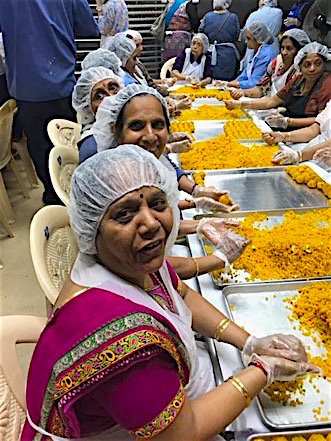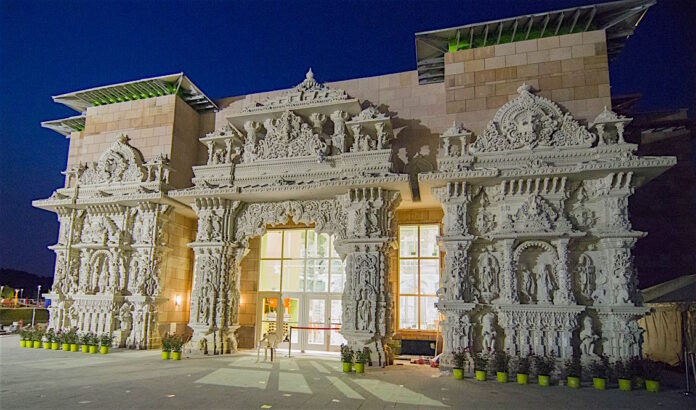Volunteers at one of America’s largest Hindu temples equate cooking with divine service
Each morning at 9, dozens of volunteers gather at a spectacular Robbinsville, New Jersey Hindu temple, to bake flatbread, make daal and shape dough for Indian sweets, for later distribution to worshippers and volunteers.
“Preparing and serving food is an act of kindness to others,” said Maansi Joshi, 17, who was pitching in at the new BAPS Shri Swaminarayan Mandir, or temple, on a recent Sunday morning. “We prepare and serve food to others because we genuinely feel the drive to serve the divinity within them.”

The massive 12,000 square foot temple, said to be one of the largest Hindu temples in North America, hosts some one thousand visitors each week. An architectural tour de force built of hand-carved Carrara marble, the temple serves New Jersey’s fast-growing Hindu community. It opened in 2014. Though the mandir is complete, construction continues on other parts of the complex, which has a target completion date of 2021.
The volunteer cooks offer three daily hot meals to some volunteer stone artisans from India who are working at the complex, and prepare the food sold at the temple’s Shayona Café. The café promotes vegetarianism, and a devotional Hindu diet.
“Food plays an important role in religious communities,” said volunteer Hasu Patel, as she rolled flatbread dough into a perfect circle. She was one of 30 women and eight men devoting their Sunday morning to food preparation.
“It is our duty to do seva,” Hasu Patel elaborated, using a Sanskrit word that means “to selflessly serve.” “By doing seva, we are not only building samp (unity) among volunteers, but we are also serving the divinity within everyone.”
“Helping humanity is a service to God,” added Smruti Brahmbhatt, a temple lead volunteer. “What we do is a step beyond community service; seva can only happen if we develop a spiritual mindset.”

The kitchen usually opens at 5 a.m., and at times, as many as 30 men and women volunteer there.
“The stone artisans work so hard on the temple,” said volunteer Vinoda Patel. “They work in hot and cold weather, rain or shine. The least we can do is prepare good food for them.”
Volunteers say seva has practical, humanitarian and theological value, and that it gives them a sense of spiritual accomplishment and strength.
Offered to God before being distributed for consumption, the food is then considered sanctified. This devotional process is the inspiration for the cooks’ efforts, said volunteer Jyostna Patel.
The temple’s food also adheres to certain dietary standards meant to promote purity, devotion and non-violence. Ingredients are free from meat-derived products, and from allium vegetables, such as onions and garlic. Volunteers are also expected to bathe and pray before handling the food.
“We believe, quite literally: we are what we eat,” Hasu Patel said. “A meal prepared with quality ingredients, by loving hands, and sanctified before consumption will leave one feeling a lot better holistically than a meal that is not prepared in such a way.”

The BAPS approach to food preparation and distribution can be traced to the tradition’s founder, Bhagwan Swaminarayan, who lived from 1781-1830. Swaminarayan asked his guru, or spiritual guide, that no devotee would suffer from a lack of food or clothing. Swaminarayan steadfastly promoted these principles for the rest of his life in Gujarat, India. He opened almshouses for the poor, and organized food and water relief during droughts.
“By engaging in this seva of cooking food for volunteers and visitors, we are reminding ourselves of the brave and charitable work that Swaminarayan did,” Hasu Patel explained. “We are following in his footsteps — and that is so spiritually fulfilling.”
Seva also fosters unity among the volunteers.
“When we do seva, we are all working together to complete the same task,” Joshi said. “As a result, we inevitably become closer through bonding. Also, it is easier to build a bond in this setting, because we all strive for the same spiritual goal, which is to align ourselves with the pious lives of our gurus.”
One of Swaminarayan’s successors, the late Pramukh Swami Maharaj, encouraged the activities of BAPS Charities, which promotes care for others, and a search for divinity within everyone.
Pramukh Swami Maharaj pursued many humanitarian efforts, including famine relief, literacy campaigns and medical initiatives.
“Serving others was the life of our gurus,” said Hasu. “So that must be our life too.”


